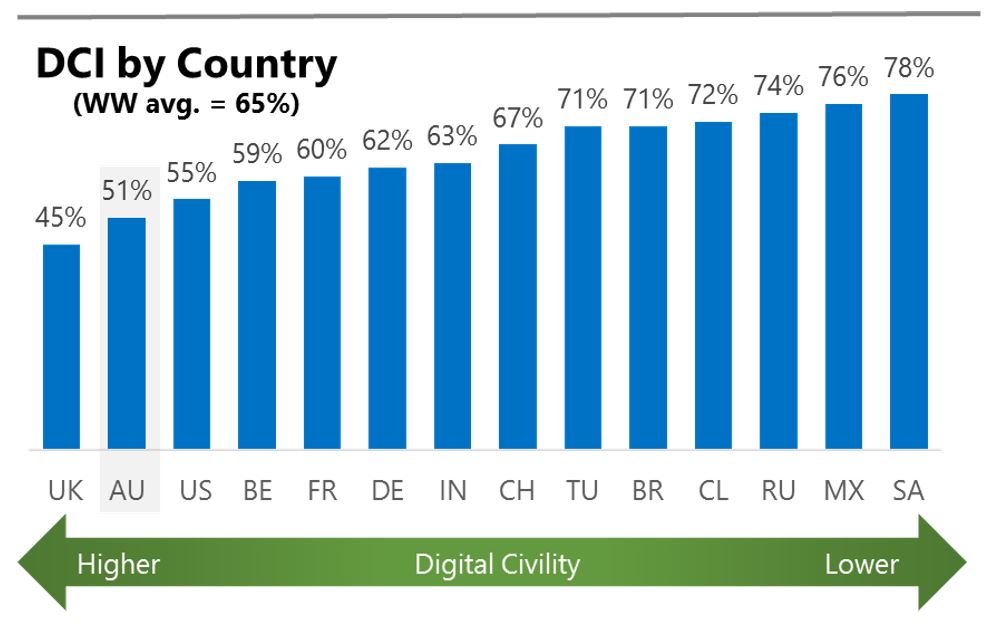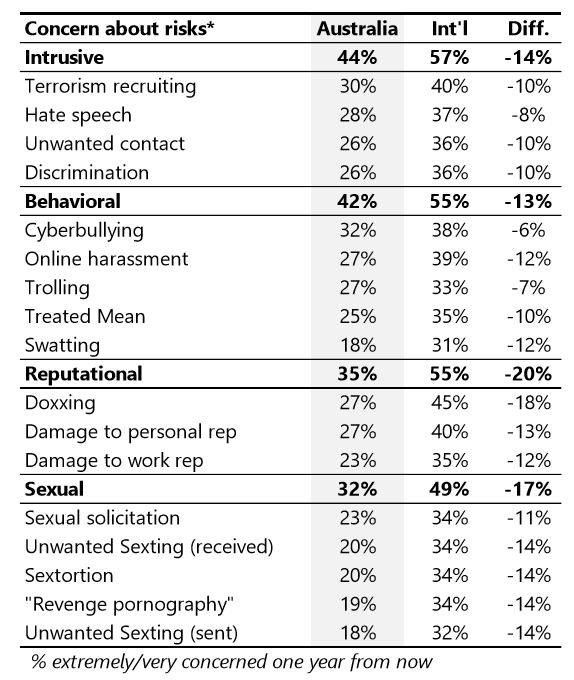Digital Civility Index (DCI) – Australia
Microsoft conducted research among adults and teenagers in 14 countries to study the level of civility across various online interactions. These results expand on the behavioural component of Microsoft’s Computer Safety Index (MCSI) by examining the extent of negative civil and personal safety interactions and their consequences.
The Digital Civility Index (DCI) measures consumers’ lifetime exposure to online risks. Online risks were divided into four categories: Behavioural, Intrusive, Reputational and Sexual. Each category consisted of several individual risks. DCI scores were calculated by using the percentage of consumers who were exposed at some point in time to at least one of 17 different online risk(s). Lower scores equate to lower online risk exposure and a higher Digital Civility.
measures consumers’ lifetime exposure to online risks. Online risks were divided into four categories: Behavioural, Intrusive, Reputational and Sexual. Each category consisted of several individual risks. DCI scores were calculated by using the percentage of consumers who were exposed at some point in time to at least one of 17 different online risk(s). Lower scores equate to lower online risk exposure and a higher Digital Civility.
Australia ranked 2nd in DCI
51% of Australians reported having ever been exposed to an online risk. Only the United Kingdom had a lower DCI score. Australia scored below international averages on nearly all category and individual risk items apart from Cyberbullying.
Intrusive
- Unwanted contact (35%) was the primary driver of Intrusive risks which had the highest score of any online risk category. The incidence of Intrusive risks was significantly lower than international (40%, 51%).
Behavioural
- Treated mean (25%) was the leading Behavioural risk and ranked second overall among all online risks.
- Trolling (20%) and Online Harassment (14%) were among the top five highest online risks.
Sexual
- Australians had a lower chance of experiencing any Sexual online risk compared to international (17%, 31%).
- Unwanted sexting (received or sent, 14%) and Sexual solicitation (8%) were the most common sexual risks.
Reputational
- People encountered Reputational risks at a lower rate than international (11% vs. 19%) led by Damage to personal reputation (6%) and Doxing (6%).
People became less trusting of others
Nearly two-thirds of Australians reported a consequence from exposure to an online risk. This was similar to the international average.
- The most common consequence from online risk exposure was a loss of trust both online (30%) and offline (27%). As a result, people tended to become more stressed and withdrawn.
- 18% tried to counterbalance negative outcomes by being more constructive in their criticism of others. This was considerably lower than similar efforts made internationally (27%).
- Consequences that were felt more strongly in Australia included Lost a friend (23%, 18%), Spent time and energy avoiding the offender (22%, 17%) and Became depressed (21%, 16%).
Online risks prompted strong concerns
41% of consumers in Australia were much more or more concerned about online risks overall. This concern was echoed more strongly outside the country. (International, 50%).
Looking one year ahead, Intrusive (44%) and Behavioural (42%) risk categories garnered the most concern both in Australia. and internationally.
- Cyberbullying (32%), Terrorism Recruiting (30%) and Hate speech (28%) were the three most concerning online risks.
- Consumers reported having lower concerns across all online risks compared to international. The largest differences were in Doxing (27%, 45%) and Sexual risks (32%, 49%).
Nearly one-quarter experienced an online risk within the past month
- 23% of Australians experienced their most recent online risk within the past month.
- 9% said the most recent online risk happened within the past week.
- 6% reported online risks happened every/almost every time compared to 12% internationally.
Demographics
Age: Unsurprisingly, youth (ages 13-17) were found to have a greater number of interactions online than adults (161, 95)[1]. Higher interactions among youth did not translate into higher rates of online risk compared to adults – if fact they were slightly lower (48%, 53%). Youth were more likely to have family or friends affected by a risk than adults (57%, 33%). This suggested youth were more willing to share their negative online experiences and may have underreported their own risk exposure.
Youth were more likely (58%, 32%) to have met in person the individual responsible for the online risk. Youth were less confident than adults in managing uncivil behaviour, (41%, 48%) but youth were much more sure of themselves about where to get help (48%, 15%) if needed.
Gender: Females reported higher levels of Cyberbullying (14%, 8%) than males. No other risks showed a significant difference by gender.
Males reported being more confident in dealing with an online risk (51%, 38%) and slightly more likely to know where to get help if needed (34%, 28%).
Females were more pessimistic about the future of safety (122, 113)[2] and shared a similar outlook with males regarding civility (106, 106)[3]







